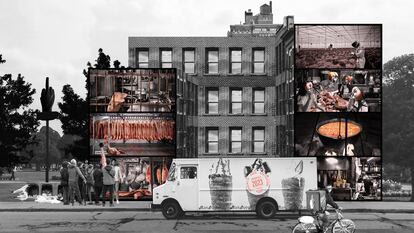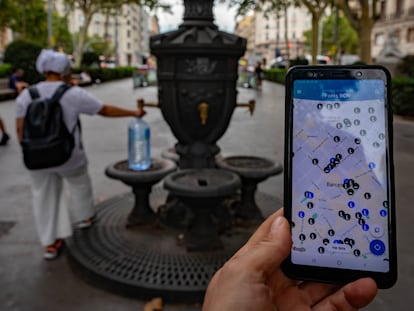How does food shape our cities?
Seeing the world through the perspective of food will help us understand how many things that may seem isolated are actually interconnected

In recent years, food has taken a prominent place in the public sphere, the political agenda and the media. Recommendations for reducing meat consumption; the annoyance caused by dark kitchens (set up exclusively for home delivery, with no place for customers) in central spaces of the city and the proliferation of distribution companies; the deforestation of large areas for productive uses of the land, GMOs and pesticides are only some of the symptoms of a conflict that transcends the economic, cultural and political dimensions to cross into the field of urban planning.
In her book Hungry Cities, architect and researcher Carolyn Steel says that cities, like people, are what they eat. A simple statement, but one of great depth, that alludes to the close relationship between the development of cities and the way in which we provide food to their inhabitants.
The impact that food has on a city is easy to see, revealing how food culture is a determining factor in the permanent reinvention of urban space. We see it in the built city: in the layout and names of some streets and squares, and in the tangible heritage embodied by storehouses or food markets. In fact, in Mediterranean cities the markets continue to be the landmarks where one can access quality and seasonal products. We also see this impact in intangible elements such as folklore, popular festivals or traditional gastronomy, as well as other cultural and artistic manifestations like photographs, paintings, novels or music.
Supplying food to cities requires a titanic effort. Currently, with more than half of the planet’s population living in urban areas, the possibility of producing, importing, marketing, preparing, consuming and disposing of food every day for the millions of inhabitants that populate cities around the world is surprising.
This effort has a physical and a social impact on our lives and on the planet, surpassing in magnitude any other activity we do. However, in the West, very few of us are fully aware of this process. Food arrives on our plates as if by magic, and we rarely take a moment to think about how it got to us.
Some data to illustrate this:
• It is currently estimated that the food supply of European cities represents up to 30% of their total ecological footprint.
• In the United Kingdom, it is estimated that the average food item travels 1,837 miles before it is eaten.
• In 2021, according to the Brazilian government, 5,110 square miles of Brazilian jungle were cut down. The main driving force behind the deforestation is the pressure exerted by the agriculture and livestock sectors for the production of soy and beef.
If we aim to inhabit a world characterized by equity and a significant reduction in CO2 emissions, we must reconsider not only the physical configuration of these cities, but also the way in which they are supplied with food, a significant challenge in a globalized economy in which the food system has established itself as a powerful, practically autonomous network. The task is not an easy one, and we all need to assume our part of responsibility and do something about it.
Those of us who work in the world of communication and culture have the responsibility of generating stories, creating narratives capable of explaining the reality in which we live and envisioning other ways of living together: telling stories with works of art, with images, with artifacts, objects, through design, architecture and more.
Seeing the world through the perspective of food can help us understand that many things that may seem isolated are actually interconnected, including the infrastructure for mobility and transportation, the matter of energy, climate change, public health and the growing obesity epidemic, the influence exerted by large corporations in the food production, the distribution and sale sectors and the progressive, unsustainable urbanization of our cities.
Sign up for our weekly newsletter to get more English-language news coverage from EL PAÍS USA Edition
Tu suscripción se está usando en otro dispositivo
¿Quieres añadir otro usuario a tu suscripción?
Si continúas leyendo en este dispositivo, no se podrá leer en el otro.
FlechaTu suscripción se está usando en otro dispositivo y solo puedes acceder a EL PAÍS desde un dispositivo a la vez.
Si quieres compartir tu cuenta, cambia tu suscripción a la modalidad Premium, así podrás añadir otro usuario. Cada uno accederá con su propia cuenta de email, lo que os permitirá personalizar vuestra experiencia en EL PAÍS.
¿Tienes una suscripción de empresa? Accede aquí para contratar más cuentas.
En el caso de no saber quién está usando tu cuenta, te recomendamos cambiar tu contraseña aquí.
Si decides continuar compartiendo tu cuenta, este mensaje se mostrará en tu dispositivo y en el de la otra persona que está usando tu cuenta de forma indefinida, afectando a tu experiencia de lectura. Puedes consultar aquí los términos y condiciones de la suscripción digital.
More information
Últimas noticias
Most viewed
- Why we lost the habit of sleeping in two segments and how that changed our sense of time
- Charles Dubouloz, mountaineering star, retires at 36 with a farewell tour inspired by Walter Bonatti
- Venezuela faces its most tense Christmas yet
- CBS in crisis after pulling a report on Trump’s deportations to El Salvador (which later leaked online)
- Bukele clan fumes over investigation exposing their new wealth










































